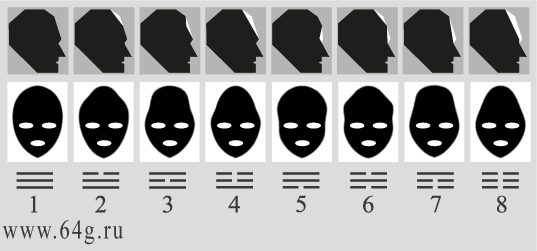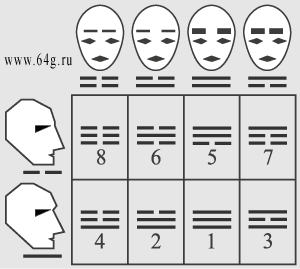-
-
Physiognomy of a forehead is complex as geometrical shapes of foreheads in frontal perspectives of human faces and concerning vertical axis of facial measurements are complex for visual identification of sizes, and also foreheads in most cases are hidden by hair. Namely it is difficult to see formal sizes of a top head part, but if it is possible then physiognomy of forehead and eyebrows can be compared with trigrams Ba Gua in the canon of changes i-jing as well as other facial traits, that is shown on the chart.

Top row of physiognomic pictures shows eight types of foreheads and eyebrows
according to lateral perspectives of a face in profile.
Bottom row of pictures shows eight physiognomic types in geometrical outlines of
foreheads and eyebrows according to frontal facial perspectives in full-face.
Physiognomic types of foreheads and eyebrows according to vertical axis of
measurements on this chart are not shown, as vertical sizes of forehead levels
in features of a face are complex for identifying. Namely the shown chart
partially compares foreheads and eyebrows to geometrical facial coordinates in a
context of physiognomy. But however ratios of potential and kinetic
psychological features of human consciousness can be analyzed by means of the
shown chart concerning horizontal axes of measurements in half and full face.
For example, forehead and eyebrows in the human face in view of physiognomy have
sizes which can be compared to the sixth trigram in full-face and to the seventh
trigram in profile, that is possible to designate F6 ![]() L7
L7 ![]() by letters and symbols of the canon i-jing.
by letters and symbols of the canon i-jing.
Ratio of psychological features according to geometrical coordinates of
consciousness in a context of physiognomy in this case have following meanings.
Top of forehead - synthesizing consciousness.
Insignificant potential tendencies of thinking do not allow to realize
significant kinetic aspirations to actualization of ideas, as break line in the
sixth trigram and entire line in the seventh trigram are on top positions that
corresponds to top of forehead which is narrow in full-face and expressed in profile.
Middle of forehead - integrating consciousness.
Significant potential possibilities of thinking cannot be realized by weak
kinetic capacity, as entire line in the sixth Ba Gua and break line in the
seventh Ba Gua are on middle positions, that corresponds to the middle of
forehead with wide sizes in full-face and not expressed sizes in profile.
Eyebrows - analytical consciousness.
Insignificant potential tendencies of thinking do not contradict insignificant
kinetic energies of mental actualization of ideas, as in the sixth and the
seventh Ba Gua of i-jing on bottom positions there are break lines that
corresponds to the narrow and not expressed outlines of eyebrows in full-face
and profile.
The information about psychological meanings of three
types of consciousness in a context of
physiognomy look on pages of this website in section with the name:
half-faces (concepts).
In a similar way formal outlines of foreheads and eyebrows can be correlated
to symbols of the canon i-jing for considering of psychological coordinates in
traits of potential and kinetic characteristics of consciousness in view of
facial physiognomy. But also it is possible to consider only eyebrows without
considering of forehead, that is shown in the table.
 |
Physiognomic pictures and digrams of the canon i-jing
at the top correspond to sizes of eyebrows according to frontal facial
perspectives and vertical measurements of a face. Namely top lines in
digrams designate sizes of eyebrows concerning vertical axis of
measurements, and bottom lines designate horizontal sizes in full-face. Physiognomic pictures and single lines of symbols i-jing at the left designate horizontal sizes of eyebrows in half-face. Trigrams Ba Gua of the canon i-jing in cells of the table develop of digrams above and single lines at the left that corresponds to three measurements of eyebrows and geometrical coordinates of analytical consciousness in a context of physiognomy of a human face. |
-
In total lines in Ba Gua of the canon i-jing in cells of the table designate
following formal parameters and geometrical measurements of eyebrows.
Entire lines above - thick on vertical.
Break lines above - thin on vertical.
Entire lines in the middle - wide in full-faces.
Break lines in the middle - narrow in full-faces.
Entire lines below - expressed in half-face.
Break lines below - not expressed in half-face.
For example, eyebrows on the human face in view of the listed formal parameters
and geometrical facial measurements correspond to the sixth ![]() trigram of the canon i-jing in the table.
trigram of the canon i-jing in the table.
In this case significant potential tendencies of analytical consciousness cannot
be realized by weak kinetic possibilities for realization of ideas, that
corresponds to the entire line on middle position and to the break line on
bottom position in trigram, and also to formal parameters of eyebrows which are
wide in full-faces and not expressed in profile according to horizontal
measurements of geometrical coordinates. Moreover, impossible kinetic
realization of ideas is aggravated by thin sizes of eyebrows on vertical, that
corresponds to the break line on top position in trigram, and as a result there
is an impression that non-realized ideas are essential psychological lack of
personality.
The shown example can be considered from the point of view of not only
physiognomy, but also cosmetic make-up or otherwise to tell stylistic design of
female faces. Namely when women correct facial features and make-up eyebrows too
thin concerning vertical axis of measurements then there is an impression that
non-realized ideas are psychological lack, in the event that eyebrows correspond
to the sixth Ba Gua of the canon i-jing in the shown table as a result of
stylistic design. But if eyebrows on a female face as a result of facial make-up
or cosmetic correction correspond to the fourth either second or eighth trigrams
then such impression does not arise.
In total Ba Gua of the canon i-jing in cells of the shown table can be
considered not only as symbols of geometrical coordinates of psychological
features of analytical consciousness in a context of physiognomy of a human
face, but also as symbols of formal facial parameters which are perceived as
positive or negative in faces of women as a result of stylistic design and
cosmetic make-up. That cosmeticians and artists of stylistic facial design, and
also managers in cosmetic beauty salons can consider.
More detailed information on visual impressions caused by ratio of potential
and kinetic properties of analytical consciousness according to other trigrams
of the canon i-jing in the shown table I shall try to publish in the future, if
such information will be demanded for use in cosmetic make-up and stylistic
facial design.
On following page shows geometrical axes of facial coordinates for physiognomic measurements of lips and chin.